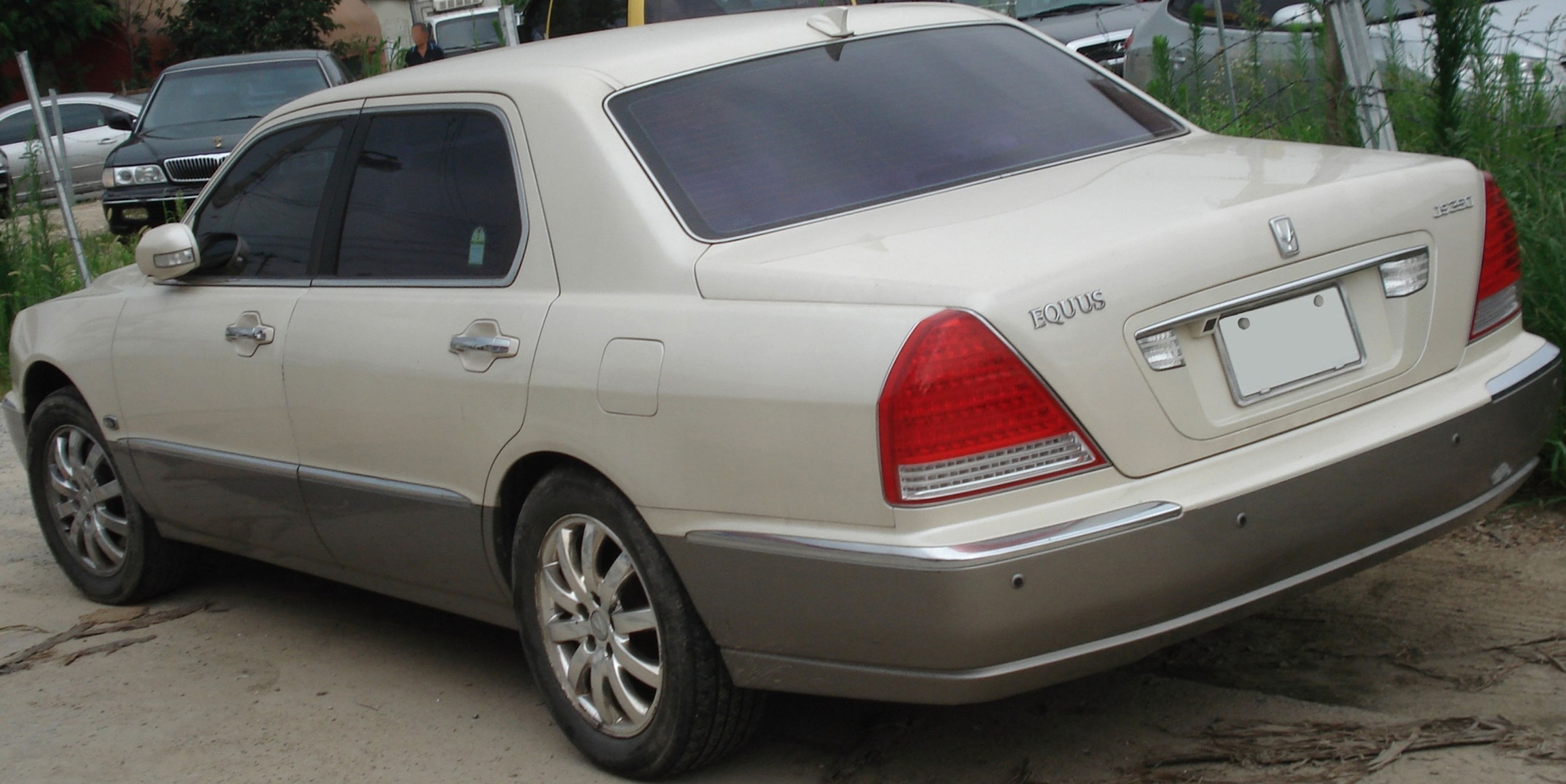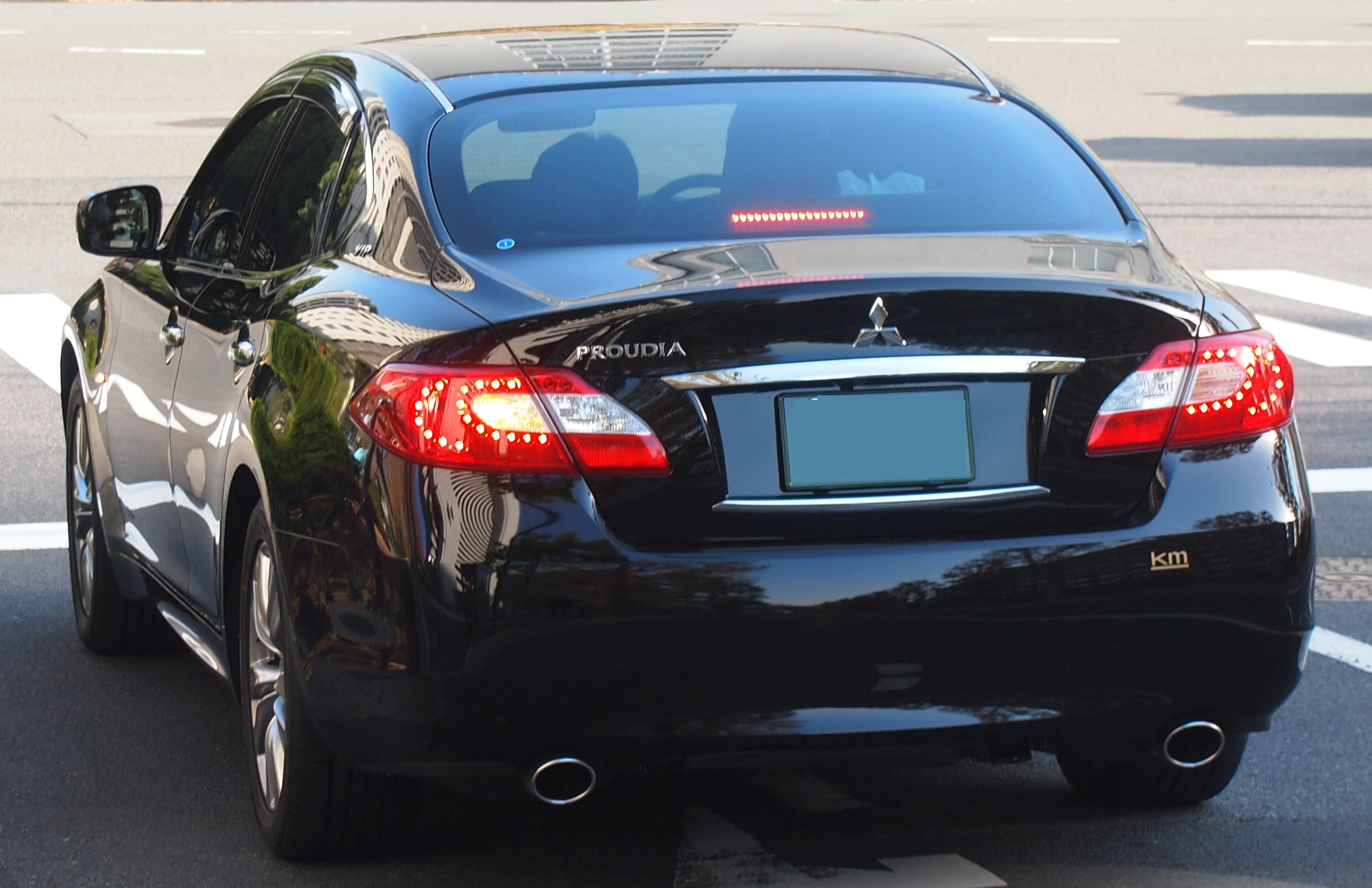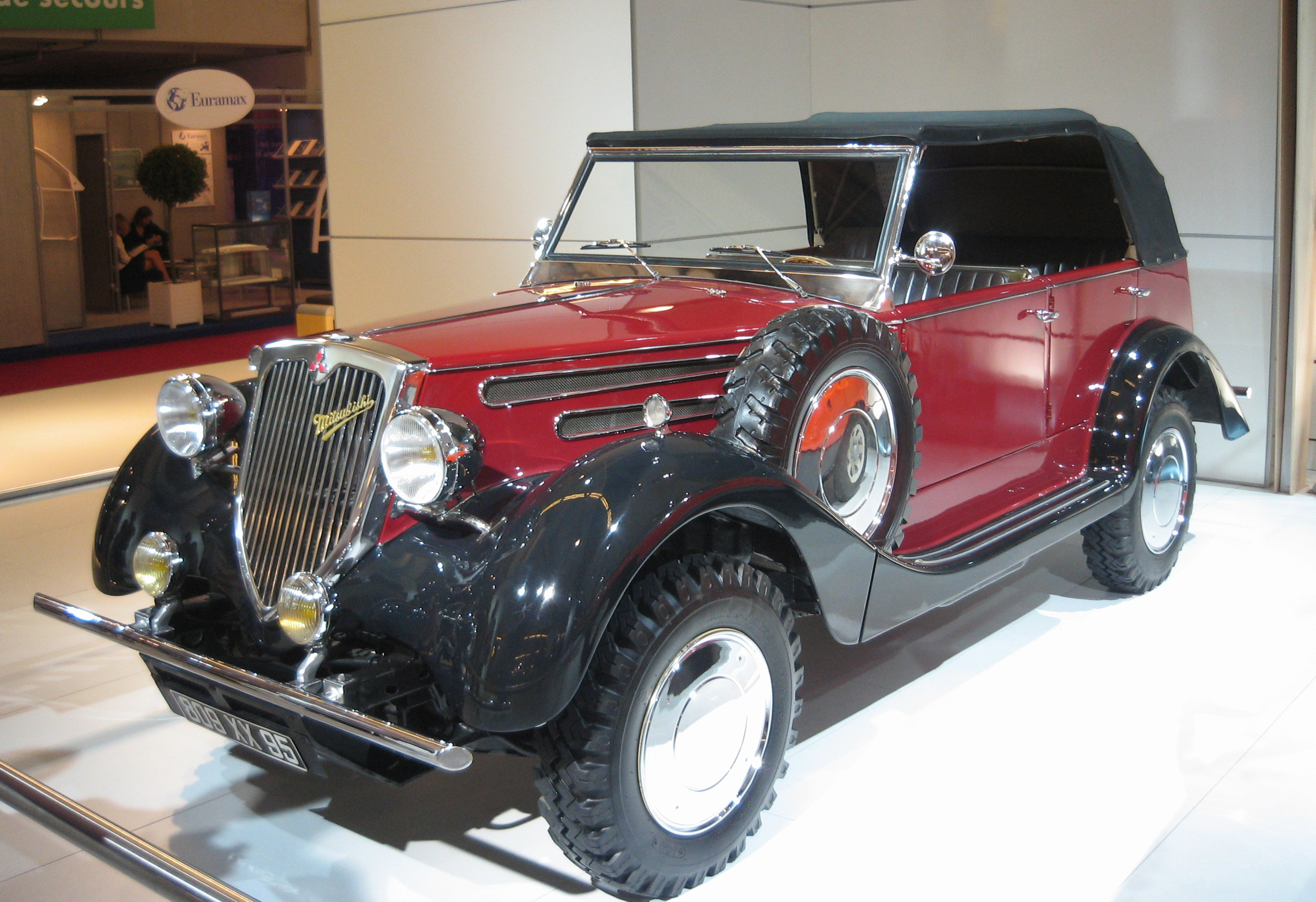|
Hyundai Equus
The Hyundai Equus () is a full-size, front-engine, rear-drive, four-door, five passenger luxury sedan manufactured and marketed by Hyundai from 1999 to 2016. The name ''" equus"'' is the Latin word for "horse". In 2009, Hyundai released the second generation with a rear-wheel drive platform and competing with the BMW 7 Series, Mercedes S-Class, Audi A8 and Lexus LS. As of August 2014, the second generation is sold in South Korea, Russia, China, United States, Canada, Central America, and South America — as well as in the Middle East under the Hyundai Centennial nameplate. On November 4, 2015, Hyundai officially announced the Genesis model would be spun off into Genesis Motor, the new luxury vehicle division for Hyundai. The 2016 successor to the Hyundai Equus has been rebranded as Genesis G90 (EQ900 in Korea until 2018). First generation (LZ/YJ; 1999) In 1999, Hyundai Motors and Mitsubishi Motors presented their full-size sedan. Hyundai said that it was making a ... [...More Info...] [...Related Items...] OR: [Wikipedia] [Google] [Baidu] |
F-segment
The F-segment is the 6th category and largest of the Euro Car Segment, European segments for passenger cars, and always belongs to "Luxury_vehicle#Luxury_saloon_/_full-size_luxury_sedan, luxury cars". The equivalent categories are full-size luxury sedan (or "large luxury sedan") in the United States, luxury saloon (or "luxury limousine") in the United Kingdom, and Oberklasse in Germany. Extended-wheelbase limousines and Armored car (VIP), armored sedans are also considered as F-segment. F-segment is a niche of the European market (approximately 0.2–0.3% in the 2010s) and the range is limited to only a few models. Characteristics Most F-segment cars use a sedan (car), sedan body style, however some have been produced as station wagons, wagons/estates or have a hatchback rear door. Extended wheelbase variants of these cars are common, as many of the luxury features are placed for the rear-seat occupants. In some markets (depending on the manufacturer), short wheelbase models ... [...More Info...] [...Related Items...] OR: [Wikipedia] [Google] [Baidu] |
Hyundai Motor Company
Hyundai Motor Company, often abbreviated to Hyundai Motors ( ) and commonly known as Hyundai (, ; ), is a South Korean multinational automotive manufacturer headquartered in Seoul, South Korea, and founded in 1967. Currently, the company owns 33.88 percent of Kia Corporation, and also fully owns two marques including its luxury cars subsidiary, Genesis Motor, and an electric vehicle sub-brand, Ioniq. Those three brands altogether comprise the Hyundai Motor Group. Hyundai operates the world's largest integrated automobile manufacturing facility in Ulsan, South Korea which has an annual production capacity of 1.6 million units. The company employs about 75,000 people worldwide. Hyundai vehicles are sold in 193 countries through 5,000 dealerships and showrooms. History Chung Ju-Yung (1915–2001) founded the Hyundai Engineering and Construction Company in 1947. Hyundai Motor Company was later established in 1967, and the company's first model, the Cortina, was relea ... [...More Info...] [...Related Items...] OR: [Wikipedia] [Google] [Baidu] |
Mercedes S-Class
The Mercedes-Benz S-Class, formerly known as ''Sonderklasse'' (German for "special class", abbreviated as "S-Klasse"), is a series of full-sized luxury sedans, limousines and armored sedans produced by the German automaker Mercedes-Benz, a division of the German company Mercedes-Benz. The S-Class is the designation for top-of-the-line Mercedes-Benz models and was officially introduced in 1972 with the W116, and has remained in use ever since. The S-Class is the flagship vehicle for Mercedes-Benz. The S-Class has debuted many of the company's latest innovations, including drivetrain technologies, interior features, and safety systems (such as the first seatbelt pretensioners). The S-Class has ranked as the world's best-selling luxury sedan. In automotive terms, ''Sonderklasse'' refers to "a specially outfitted car." Although used colloquially for decades, following its official application in 1972, six generations of officially named ''S-Klasse'' sedans have been produced. In ... [...More Info...] [...Related Items...] OR: [Wikipedia] [Google] [Baidu] |
V6 Engine
A V6 engine is a six-cylinder piston engine where the cylinders share a common crankshaft and are arranged in a V configuration. The first V6 engines were designed and produced independently by Marmon Motor Car Company, Deutz Gasmotoren Fabrik and Delahaye. Engines built after World War II include the Lancia V6 engine in 1950 for the Lancia Aurelia, and the Buick V6 engine in 1962 for the Buick Special. The V6 layout has become the most common layout for six-cylinder automotive engines. Design Due to their short length, V6 engines are often used as the larger engine option for vehicles which are otherwise produced with inline-four engines, especially in transverse engine vehicles. A downside for luxury cars is that V6 engines produce more vibrations than straight-six engines. Some sports cars use flat-six engines instead of V6 engines, due to their lower centre of gravity (which improves the handling). The displacement of modern V6 engines is typically between , though ... [...More Info...] [...Related Items...] OR: [Wikipedia] [Google] [Baidu] |
Hyundai Sigma Engine
The Hyundai Sigma engine is a series of V6 piston engines from Hyundai Motor Company, based on the Mitsubishi 6G7 engine. The Sigma engine family began life with the simple V6 name. Displacement ranges from . 2.5L (G6AV) The DOHC G6AV (also called the 2.5 D) is the small version. Bore is and stroke is shared with the at . Output is at 6,000 rpm and at 4,500 rpm. Applications *Hyundai Dynasty (1997–2005) * Hyundai Grandeur (LX) (1995–1998) * Hyundai Marcia (1995–1998) 3.0L (G6AT/G6CT) The DOHC G6AT and G6CT (also called the 3.0 D) both displace . They share the 2.5's stroke but use a larger bore. Output for the older G6AT is at 6,000 rpm and at 4,000–4,500 rpm, while the G6CT produces at 5,500–6,000 rpm and at 3,500–4,000 rpm. The older SOHC G6AT 3.0 S produces just at 5,000 rpm and at 2,500–3,000 rpm. Applications * Hyundai Dynasty (1996–2005) * Hyundai Equus (LZ) (1999–2005) * Hyundai Galloper (1994� ... [...More Info...] [...Related Items...] OR: [Wikipedia] [Google] [Baidu] |
Petrol Engine
A petrol engine (gasoline engine in American English) is an internal combustion engine designed to run on petrol (gasoline). Petrol engines can often be adapted to also run on fuels such as liquefied petroleum gas and ethanol blends (such as ''E10'' and ''E85''). Most petrol engines use spark ignition, unlike diesel engines which typically use compression ignition. Another key difference to diesel engines is that petrol engines typically have a lower compression ratio. Design Thermodynamic cycle Most petrol engines use either the four-stroke Otto cycle or the two-stroke cycle. Petrol engines have also been produced using the Miller cycle and Atkinson cycle. Layout Most petrol-powered piston engines are straight engines or V engines. However, flat engines, W engines and other layouts are sometimes used. Wankel engines are classified by the number of rotors used. Compression ratio Cooling Petrol engines are either air-cooled or water-cooled. Ignition Petrol e ... [...More Info...] [...Related Items...] OR: [Wikipedia] [Google] [Baidu] |
Longitudinal Engine
In automotive engineering, a longitudinal engine is an internal combustion engine in which the crankshaft is oriented along the long axis of the vehicle, front to back. Use This type of motor is usually used for rear-wheel drive cars, except for some Audi and SAAB models equipped with longitudinal engines in front wheel drive. In front-wheel drive cars a transverse engine is usually used. Trucks often have longitudinal engines with rear-wheel drive. For motorcycles, the use of a particular type depends on the drive: in case of a chain or belt drive a transverse engine is usually used, and with shaft drives a longitudinal engine. Longitudinal engines in motorcycles do have one disadvantage: the "tipping point" of the crankshaft tilts along the entire motorcycle to a greater or lesser degree when accelerating. This is partly resolved by having other components, such as the generator and the gearbox, rotate in the opposite direction to the crankshaft. Most larger, "premium" ve ... [...More Info...] [...Related Items...] OR: [Wikipedia] [Google] [Baidu] |
Mitsubishi Dignity
The is a full-size luxury car originally manufactured by Mitsubishi Motors from late 1999 to 2001 as the flagship of the company's domestic range, alongside the shorter Proudia, and was reintroduced 2012 to Japanese buyers as a rebadged fifth-generation Nissan Cima. The Dignity was discontinued for the second time in 2016. In Japan, it was sold at a specific retail chain called '' Galant Shop''. The name "Dignity" was used to describe the "peerless grandeur and majestic stateliness" of the model. __TOC__ First generation (S43A; 1999) The Dignity/Proudia range was designed by Mitsubishi Motors and co-manufactured with Hyundai of South Korea, who marketed their own version as the Hyundai Equus (from 1999 to 2009)."Mitsubishi's new flagships" , Jack Yamaguchi, Automotive Engineering International Online, Mar ... [...More Info...] [...Related Items...] OR: [Wikipedia] [Google] [Baidu] |
Mitsubishi Proudia
The is a Luxury car, luxury Sedan (automobile), sedan manufactured by Mitsubishi Motors, positioned below the Flagship#Automobiles, flagship Mitsubishi Dignity, Dignity limousine (itself a lengthened version of the Proudia) in the company's range. Its name is a portmanteau derived from the English word "proud" and "diamond" (referring to the company's logo)."Luxury sedan and limousine models" , Mitsubishi Motors press release, December 20, 1999 The first generation was produced from late 1999 to 2001, while the second generation (a rebadged Nissan Fuga#Y51, second-generation Nissan Fuga) was produced from 2012 to 2016. __TOC__ First generation (S32A/S33A; 1999) The Proudia/Dignity range was designed by Mitsubishi Motors and co-manufactured with Hyu ...[...More Info...] [...Related Items...] OR: [Wikipedia] [Google] [Baidu] |
Mitsubishi Motors
is a Japanese multinational automobile manufacturer headquartered in Minato, Tokyo, Japan.Corporate Profile , Mitsubishi Motors website, 19 June 2008 In 2011, Mitsubishi Motors was the sixth-largest Japanese and the 19th-largest worldwide by production. Since October 2016, Mitsubishi has been one-third (34%) owned by , thus a part of the Renault–Nissan–Mitsubishi Alliance. Besides being part of the ... [...More Info...] [...Related Items...] OR: [Wikipedia] [Google] [Baidu] |
Reuters
Reuters ( ) is a news agency owned by Thomson Reuters Corporation. It employs around 2,500 journalists and 600 photojournalists in about 200 locations worldwide. Reuters is one of the largest news agencies in the world. The agency was established in London in 1851 by the German-born Paul Reuter. It was acquired by the Thomson Corporation of Canada in 2008 and now makes up the media division of Thomson Reuters. History 19th century Paul Reuter worked at a book-publishing firm in Berlin and was involved in distributing radical pamphlets at the beginning of the Revolutions in 1848. These publications brought much attention to Reuter, who in 1850 developed a prototype news service in Aachen using homing pigeons and electric telegraphy from 1851 on, in order to transmit messages between Brussels and Aachen, in what today is Aachen's Reuters House. Reuter moved to London in 1851 and established a news wire agency at the London Royal Exchange. Headquartered in London, Reuter' ... [...More Info...] [...Related Items...] OR: [Wikipedia] [Google] [Baidu] |
Luxury Vehicle
A luxury car is a car that provides increased levels of comfort, equipment, amenities, quality, performance, and associated status compared to moderately priced cars. The term is subjective and reflects both the qualities of the car and the brand image of its manufacturer. Luxury brands rank above ''premium brands'', though there is no fixed demarcation between the two. Traditionally, most luxury cars were large vehicles, though smaller sports-oriented models were always produced. "Compact" luxury vehicles such as hatchbacks, and off-road capable sport utility vehicles, are relatively modern trends. Classification standards Several car classification schemes include a luxury category, such as: * Australia: Since the year 2000, the Federal Government's luxury car tax applies to new vehicles over a certain purchase price, with higher thresholds applying for cars considered as fuel efficient. As of 2019, the thresholds were approximately AU$66,000 (US$,000) for normal cars ... [...More Info...] [...Related Items...] OR: [Wikipedia] [Google] [Baidu] |

.jpg)


.jpg)



